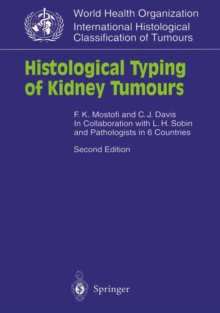
Histological Typing of Tumours of the Gallbladder and Extrahepatic Bile Ducts Paperback / softback
by Jorge Albores-Saavedra, D.E. Henson, Leslie H. Sobin
Part of the WHO. World Health Organization. International Histological Classification of Tumours series
Paperback / softback
Description
This is a classification of tumours and tumour-like lesions of the gall- bladder and extrahepatic bile ducts, including the ampulla of Vater.
Although most of the lesions are found in all three sites, variations in frequency of the histological types occur and will be noted.
The incidence of carcinoma of the gallbladder varies in different parts of the world.
Variation is also found in different ethnic groups within the same country.
In the United States, for example, carcino- ma of the gallbladder is more common in American Indians than in Caucasians or in Blacks; the rate among female American Indians is 21 per 100000 compared with 1.4 per 100000 among Caucasian fe- males.
In Latin American countries, the highest rates are found in Chile, Mexico and Bolivia.
In other countries, such as Japan, the inci- dence rates are intermediate between those of American Indians and those of Caucasians.
Despite certain features in common, carcinomas of the gallblad- der and carcinomas of the extrahepatic bile ducts show a number of differences.
Gallbladder carcinomas are usually associated with cholelithiasis and have a strong female predominance. In contrast, extrahepatic bile duct carcinomas are seen less often, occur in both sexes with equal frequency, are usually not associated with choledo- cholithiasis, produce early biliary obstruction, and are better differen- tiated histologically as a group.
Moreover, they are seen in patients with primary sclerosing cholangitis and ulcerative colitis.
Information
-
Item not Available
- Format:Paperback / softback
- Pages:77 pages, 80 Illustrations, black and white; XI, 77 p. 80 illus.
- Publisher:Springer-Verlag Berlin and Heidelberg GmbH & Co. K
- Publication Date:15/02/1991
- Category:
- ISBN:9783540528388
Other Formats
- PDF from £76.08
Information
-
Item not Available
- Format:Paperback / softback
- Pages:77 pages, 80 Illustrations, black and white; XI, 77 p. 80 illus.
- Publisher:Springer-Verlag Berlin and Heidelberg GmbH & Co. K
- Publication Date:15/02/1991
- Category:
- ISBN:9783540528388










